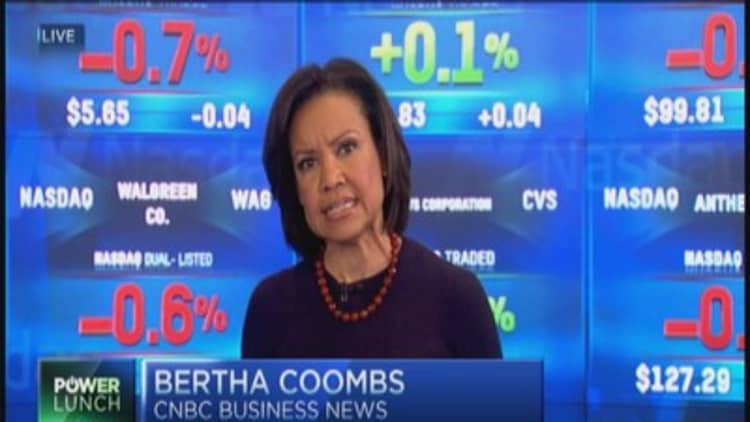Santa Claus is going to be bringing lots of presents in a couple of weeks, but lower health-insurance costs for most Americans won't be one of them.
People with insurance through an employer—that is, most people with health coverage—are paying "more in premiums and deductibles than ever before" as those costs outpace the growth of wages, a new report finds.
Total premiums for covering a family through an employer-based plan rose 73 percent from 2003 through 2013, while workers' personal share of those premium costs leaped 93 percent during the same time frame, the Commonwealth Fund report said. At the same time, median family income grew just a measly 16 percent.
If that wasn't painful enough, deductibles—or the amount a person has to pay out of pocket before an insurance plans covers medical costs—more than doubled over the 10-year span.
Read MoreOne 'buck' a day for keeping the MD away
And despite a recent slowdown in costs that coincided with the adoption of the Obamcare health-care reform law in 2010, the price of job-based coverage is still rising faster than incomes, according to the report.
Families are "being squeezed by health-care costs," said report co-author Sara Collins, vice president for Health-Care Coverage and Access at the Commonwealth Fund. "Growth in family income is so slow that people still feel a pinch from health costs."
Job-based health insurance is, by far, the single biggest form of health coverage in the United States. Some 153 million people, or 57 percent of the population, are covered by health plans offered by their employer, or the employer of their spouse or parents, while the biggest provider is government-run Medicaid, which covers about 50 million poor adults and children.
From 2003 to 2013, the average premium for an individual worker covered by a job-based plan rose from $3,481 per year to $5,571 per year—a 60 percent increase.
Family coverage, which grew by 73 percent, went from an average of $9,249 in 2013 up to $16,029 in 2013, according to the Commonwealth Fund.
Because of the relatively slow growth in wages at the same time, total average premiums paid for a family getting coverage through a job went from being 15 percent of median income in 2003 to 23 percent in 2013.
Read MoreVaccination laggards vex parents
The bulk of the premiums for job-based health insurance is still paid by employers, as opposed to the employees covered by plans.
But since 2003, employees have had to shoulder a bigger share of those premiums, and a significantly large out-of-pocket costs, specifically deductibles, as employers sought ways to control their health-care costs. And more workers are covered by plans that have deductibles now than did a decade ago.

In 2003, a worker whose plan just covered herself was, on average, paying an average of $606 annually to the cost of her plans' premiums annually, or 17 percent of the total premiums, with her employer picking up the rest of the tab, the Commonwealth Fund report said.
But by 2013, her share of the premiums had risen to 21 percent of the total premiums, or $5,571 annually.
In 2003, only slightly more than half of workers in a health plan had a deductible they had to pay. But in 2013, that had risen to 81 percent of all such workers.
And the amount of the average deductible, across all firms, had grown from an average of $1,079 for a family plan in 2003 up to $2,491 by 2013, the report found.
The Commonwealth Fund report noted that the spikes in premiums and deductibles slowed down from 2010 through 2013. For example, while the average rate of growth in costs for all job-based plans that cover only a worker grew by 5.1 percent annually from 2003 through 2013, the annual rate of growth was just 4.1 percent in the last four years of that span.
Read More'Kickback' flak: Sanofi's caseload grows bigger
Collins, the report author, said the deceleration in health-coverage costs is "probably a combination" of both the sluggish economy on the heels of the 2008-2009 financial meltdown, and some of the effects of the Affordable Care Act, popularly known as Obamacare.
Collins said premiums reflect the underlying cost of health services, whose growth rate has slowed in the past five years. Some of that is due to reduced demand as a result of the lackluster economy.
At the same time, Obamacare proponents have said the law has helped tamp down costs by penalizing hospitals for excessive rates of readmissions of patients covered by Medicare, and by setting a floor for the percentage of premiums that insurers must pay out to cover health services or pay consumers rebates.
However, Collins noted, Obamacare also contains some inflationary drivers for employer-based health plans, including the rule allowing adults below the age of 26 to remain on their parents' plans, and the provision that requires plans to cover the costs of preventative health services such as birth control without requiring any co-payment.
"Despite those changes," she said, "we're seeing an overall leveling off in the rate of growth of premiums."
"But because incomes have grown so slowly, you still have an [insurance cost] growth rate ahead of income," Collins said.


